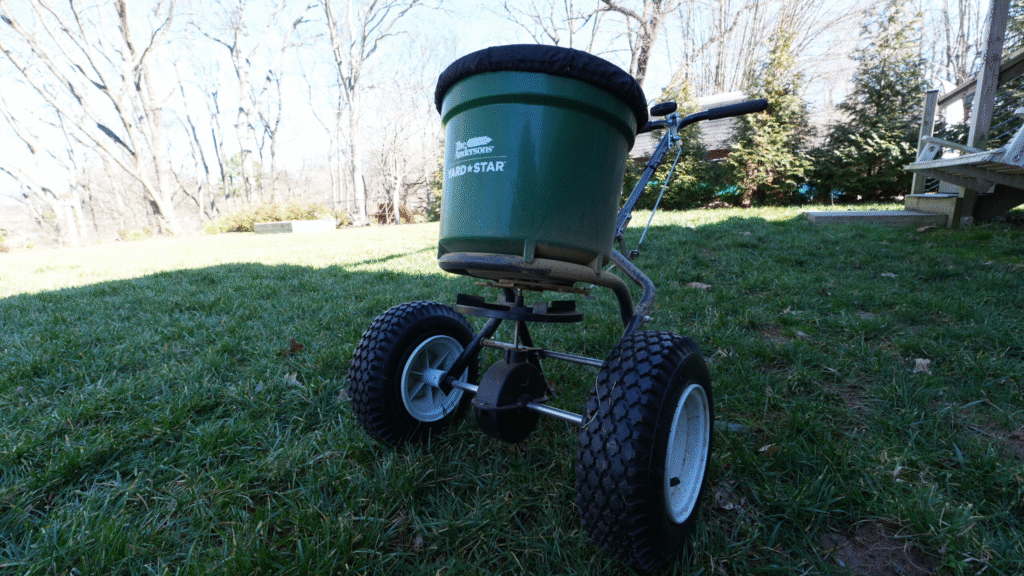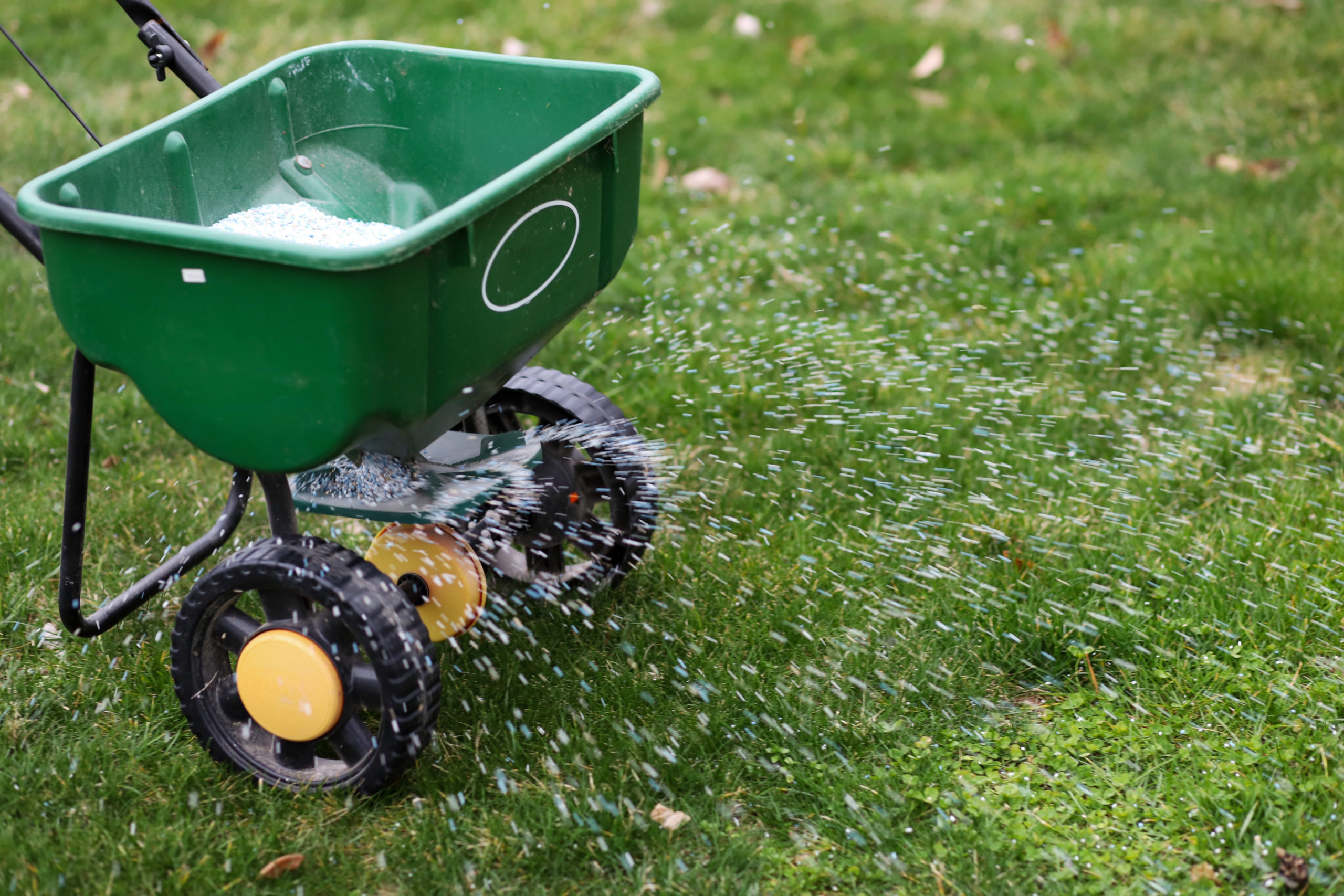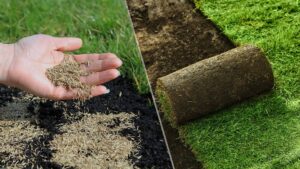The Complete Guide to Using a Broadcast Spreader: Achieve Professional Results on Your Lawn
A well-maintained lawn doesn’t happen by accident. Whether you’re applying fertilizer, grass seed, or ice melt, a broadcast spreader is one of the most valuable tools in your lawn care arsenal. This versatile piece of equipment helps you distribute materials evenly across your property, saving you time while ensuring consistent coverage that leads to better results.
What Is a Broadcast Spreader?
A broadcast spreader, sometimes called a rotary spreader, is a lawn care tool designed to distribute granular materials over large areas. Unlike drop spreaders that release material directly below the unit, broadcast spreaders use a spinning mechanism to throw or “broadcast” materials in a fan-shaped pattern, allowing you to cover more ground with each pass.
These versatile tools can handle a wide range of materials including:
- Fertilizer
- Grass seed
- Weed control products
- Soil amendments
- Salt or ice melt
- Pelleted lime
Homeowners with lawns of nearly any size can benefit from using a broadcast spreader, though they’re especially valuable for properties with more than 1,000 square feet of turf.
Types of Broadcast Spreaders
Before diving into how to use a broadcast spreader, it’s important to understand the different types available so you can choose the one that’s right for your needs.
Push Broadcast Spreaders
Push broadcast spreaders feature a hopper mounted on wheels with a handle for pushing. As you walk behind the spreader, the wheels turn a gear mechanism that rotates the spreading plate. These are ideal for medium to large lawns and offer several advantages:
- Greater capacity than handheld models
- More consistent application rates
- Less physical strain during use
- Better for covering larger areas
Most homeowners with lawns of 5,000 square feet or more will benefit from a push model.
Handheld Broadcast Spreaders
Handheld broadcast spreaders are smaller, portable units that you carry while walking. They typically have a hand crank that you turn to operate the spreading mechanism. These compact spreaders are perfect for:
- Small lawns under 5,000 square feet
- Applying materials in tight spaces
- Spot treatments
- Areas with obstacles or irregular shapes
- Storage in limited space
Tow-Behind Broadcast Spreaders
For very large properties, tow-behind broadcast spreaders attach to a riding lawn mower or garden tractor. These have the largest capacity and can cover extensive areas quickly. They’re best suited for:
- Properties over an acre in size
- Professional landscapers
- Anyone with a riding mower or ATV
- Those who need to apply materials to large areas regularly

Choosing the Right Broadcast Spreader
According to the United States Department of Agriculture’s Natural Resources Conservation Service, selecting the appropriate spreader type and size is crucial for efficient lawn care practices (https://www.nrcs.usda.gov/conservation-basics/conservation-by-state/connecticut/resources/lawn-management). When selecting a broadcast spreader, consider:
- Lawn size: Larger lawns require bigger hoppers to reduce refill frequency
- Material types: Some spreaders handle certain materials better than others
- Construction quality: Look for corrosion-resistant materials, especially for fertilizer and ice melt
- Spread width: Wider spread patterns cover ground faster but may be less precise
- Adjustability: Quality spreaders offer precise control over application rates
- Ease of cleaning: Fertilizer residue can corrode metal parts if not properly cleaned
How to Set Up Your Broadcast Spreader
Before you begin spreading materials across your lawn, proper setup is essential for achieving optimal results. Here’s how to prepare your broadcast spreader:
Assembly
Most new broadcast spreaders require some assembly. Follow the manufacturer’s instructions carefully, paying particular attention to:
- Attaching the handle to the hopper base
- Installing the spreading mechanism correctly
- Securing all bolts and fasteners
- Checking that the flow control lever moves freely
- Ensuring wheels rotate smoothly
Calibration
Perhaps the most critical step in using a broadcast spreader effectively is proper calibration. Different materials flow at different rates, and applying too much or too little can damage your lawn or waste expensive products.
To calibrate your spreader:
- Check your product packaging for the recommended setting for your specific spreader model
- If no specific setting is listed, start with a lower setting (you can always apply more)
- Test the flow rate by spreading material over a measured area (like a tarp or driveway)
- Weigh how much material was dispensed and adjust accordingly
- Keep a notebook of settings for different products for future reference
How to Load a Broadcast Spreader
Loading your spreader properly helps ensure even distribution and prevents waste:
- Place the spreader on a flat, hard surface like a driveway or sidewalk
- Close the flow control lever completely
- Check that the opening at the bottom of the hopper is fully closed
- Fill the hopper no more than ¾ full to prevent overflow and clogging
- Break up any clumps in the material before adding it to the hopper
For materials like fertilizer that contain different nutrients, give the bag a good shake before opening to ensure the components are well-mixed.
Operating Your Broadcast Spreader Effectively
Now that your spreader is assembled, calibrated, and loaded, you’re ready to apply materials to your lawn. Follow these steps for the most effective application:
Before You Start
- Mow your lawn before spreading materials when possible
- Apply when the grass is dry but before a light rain for best results with many products
- Plan your walking pattern to ensure complete coverage
- Block off areas where you don’t want material applied (gardens, driveways)
Applying Materials
The technique you use when operating a broadcast spreader significantly impacts the evenness of your application:
- Start with the spreader closed, then open it once you begin walking
- Walk at a consistent pace – changes in speed affect spread rate
- Maintain the same walking speed you used during calibration
- Release the material when you start walking, not while standing still
- Close the flow control when turning or stopping to prevent over-application
- Create a border around the perimeter first, then fill in with parallel passes
Pattern and Coverage
For optimal coverage:
- Walk in straight, parallel lines across your lawn
- Overlap each pass slightly (usually by about 1-2 feet) to ensure even coverage
- Make your passes perpendicular to slopes rather than up and down them
- For maximum evenness, consider making a second pass at right angles to the first, using half the application rate each time

Material-Specific Application Tips
Different lawn care materials require slightly different approaches when using a broadcast spreader. Here’s a helpful table outlining how to adjust your technique based on what you’re applying:
| Material | Best Spreader Type | Ideal Walking Speed | Pattern | Special Considerations |
|---|---|---|---|---|
| Fertilizer | Push or tow-behind | Moderate pace | Single or double pass | Clean spreader thoroughly after use to prevent corrosion |
| Grass Seed | Push with precision setting | Slow pace | Double pass (perpendicular patterns) | Mix with sand for better visibility and even distribution |
| Weed Control | Any broadcast type | Moderate pace | Single pass | Apply when forecast calls for no rain for 24-48 hours |
| Soil Amendments | Push or tow-behind | Moderate pace | Single pass | Often requires higher settings due to density |
| Ice Melt | Handheld or push | Quick pace | Single pass | Use corrosion-resistant models; clean immediately after |
| Lime | Push or tow-behind | Moderate pace | Double pass | May require multiple applications over time |
Maintaining Your Broadcast Spreader
Proper maintenance extends the life of your broadcast spreader and ensures it continues to perform at its best:
After Each Use
- Empty any remaining material back into its original container
- Rinse the hopper and spreading mechanism thoroughly with water
- Allow the spreader to dry completely before storage
- Pay special attention to cleaning after applying fertilizer, as it’s particularly corrosive
Seasonal Maintenance
At least once per season:
- Check and tighten all bolts and fasteners
- Lubricate moving parts according to the manufacturer’s recommendations
- Inspect wheels for smooth operation and proper alignment
- Check the flow control mechanism for accurate settings
- Store in a dry location protected from the elements
Common Issues and Fixes
Even well-maintained spreaders can develop problems. Here are solutions to common issues:
Uneven spreading: Check for clogs in the hopper opening or debris around the spreading plate. Ensure the spreader is level when in use.
Inconsistent flow: The flow control may be sticking or damaged. Clean thoroughly and lubricate if needed.
Material leaking when closed: The flow control may not be fully closing or could be damaged. Adjust or replace if necessary.
Wheels not turning properly: Clean axles and bearings, then lubricate according to manufacturer instructions.
Advanced Techniques for Professional Results
Once you’ve mastered the basics, these advanced techniques can help you achieve professional-quality results:
Split Applications
For better absorption and to reduce the risk of burning your lawn, consider applying half the recommended rate in one direction, then applying the remaining half perpendicular to the first application. This technique is especially useful for:
- High-nitrogen fertilizers
- Weed and feed products
- Overseeding existing lawns
- Applying lime
Edge Guarding
Many premium broadcast spreaders include an edge guard feature that blocks spreading on one side. This helps prevent materials from reaching:
- Driveways and walkways
- Landscape beds and gardens
- Water features
- Neighboring properties
If your spreader lacks an edge guard, consider using a drop spreader for these boundary areas instead.
Weather Considerations
Timing your application based on weather conditions dramatically affects results:
- Apply most fertilizers before light rain for natural watering-in
- Avoid spreading materials on windy days, which can create uneven distribution
- For pre-emergent herbicides, apply when soil temperatures reach the appropriate level (usually around 55°F)
- Ice melt works best when applied just before predicted snowfall or freezing rain
Environmental Considerations
Using your broadcast spreader responsibly helps protect waterways and wildlife:
- Never apply materials directly before heavy rain to prevent runoff
- Keep materials at least 10-20 feet away from water bodies
- Clean your spreader on grassy areas rather than hard surfaces where rinse water can enter storm drains
- Follow package directions for application rates—more is not better
- Consider using organic or slow-release products that pose fewer environmental risks
The Environmental Protection Agency provides guidelines for lawn care practices that minimize environmental impact, particularly regarding fertilizer use and runoff prevention (https://www.epa.gov/nutrientpollution/sources-and-solutions-consumer).

Safety Precautions
When using a broadcast spreader, especially with fertilizers and chemical treatments, keep these safety tips in mind:
- Wear gloves to prevent skin contact with chemicals
- Consider safety glasses to protect your eyes from dust and granules
- Read and follow all product labels carefully
- Keep children and pets off treated areas for the recommended time period
- Store lawn care products in their original containers, out of reach of children and pets
- Wash hands thoroughly after handling any lawn care materials
Broadcast Spreader vs. Drop Spreader: When to Use Each
While this guide focuses on broadcast spreaders, it’s worth understanding when a drop spreader might be the better choice:
Use a broadcast spreader when:
- Covering large areas quickly is the priority
- The lawn has few obstacles or borders
- You’re applying materials that benefit from wide distribution
Use a drop spreader when:
- Precision is more important than speed
- Working in narrow spaces or along defined borders
- Applying materials that require exact placement
- Working in windy conditions
Many lawn care enthusiasts own both types and use them for different purposes or areas of their property.
Seasonal Applications Guide
Your broadcast spreader can be useful year-round. Here’s when to use it for various applications:
Spring:
- Apply pre-emergent herbicides for weed prevention
- Spread starter fertilizer for new growth
- Overseed bare patches as soil temperatures warm
Summer:
- Apply slow-release fertilizers for sustained feeding
- Spread insect control products as needed
- Apply supplemental iron products for deep green color
Fall:
- Spread winterizing fertilizer to strengthen roots
- Apply lime if soil tests indicate the need
- Overseed to thicken turf before winter
Winter:
- Spread ice melt products on walkways and driveways
- Apply snow mold preventatives in susceptible regions
Conclusion
A broadcast spreader is an invaluable tool that helps you maintain a healthy, vibrant lawn with professional results. By understanding the proper techniques for setup, calibration, operation, and maintenance, you’ll get the most from your investment while achieving consistent coverage of whatever materials you’re applying.
Remember that patience and attention to detail make all the difference when using a broadcast spreader. Take the time to calibrate properly, walk at a consistent pace, and clean your equipment thoroughly after each use. These simple practices will ensure years of reliable service from your spreader and beautiful results for your lawn.
Whether you’re a first-time homeowner or a seasoned lawn enthusiast, mastering the use of a broadcast spreader puts you firmly on the path to achieving the lush, healthy lawn you’ve always wanted. With regular, proper use, your broadcast spreader will help transform your outdoor space into the envy of the neighborhood.






